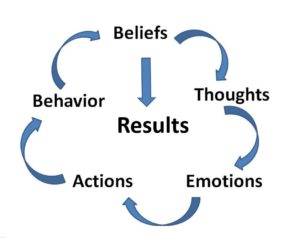How to Be Unstoppable – Part of Chapter III of the upcoming book Find Your Passion
![]()
How to Be Unstoppable – Part of Chapter III of the upcoming book Find Your Passion
We just finished the “Foundations”, the first part and letter of the F.E.A.R.S Release System. In this chapter, we’ll complete all the other parts: “Education”, “Awareness”, “Reset”, and “Stay Motivated”. It’s for you to learn more about the nature of fear, get the tools to discover and overcome your own fears that have been holding you back so far from discovering and following your passion, as well as have a few additional strategies for you to stay motivated during the process and your passion journey.
Education
What is fear anyway?
In the first chapter, we mentioned that fear is based on our mindset, and that the last one consists of our belief system. We didn’t explain though why. Why fears come from the mind? Furthermore, what’s the relationship between our fears and our belief system? Do you remember this?

So far, you do know how your beliefs, limiting or empowering, influence your thoughts, emotions, behavior, and results. Remember that your beliefs are statements stored in your long-term memory, in your subconscious mind. You’ve learned these beliefs throughout your life, especially at a very early age, by anyone who had an impact on you, a positive or negative one, and anyone who played a role in your education, including your family, friends, teachers, and the society you were raised in.
So, what is fear and where does it fit in the above model? Before we dive into this, I want you to pay 1000% attention here and right now. This info is going to change your life. Yes, I mean it. So, eliminate any distractions and don’t do anything else at the same time, whether it’s eating, listening to music, chatting with someone, virtually or physically, or anything else, stop it now. Just keep breathing, keep your eyes open, and read carefully. Ready? Here it goes. Fear is a feeling, not an emotion. The difference? Although in our day-to-day language we give them the same meaning, in neuroscience they are different. Put it very simply, a feeling is a thought that you have about a physical reaction in your body. Emotion is the physical reaction itself.
For example, have you ever noticed why nurses and doctors do small talk with you before they do anything that can be painful? A nurse has a little chat with the patient before she proceeds with an injection. Why? Of course, she builds rapport with the patient to make them feel comfortable and built trust, like many successful professionals in the medical field do. But they do small talk for another reason as well: To distract the patient from thoughts relevant to the potential pain they might feel. Why is this important? Because if the patient starts thinking about the potential pain, they will actually intensify the pain caused by the injection, or generally any treatment that might cause pain. The pain itself is nothing but a physical reaction of your body, such as your skin, cells, blood, and electric currents.
But when we think about the pain in advance, most of the time we think a negative thought. Many times we also think of the “worst-case” scenario. This varies based on one’s imagination! In the example of the injection, it might be for the patient to lose his arm or even die! The majority of “worst-case” scenarios end up, one way or another, to fear of suffering and fear of death. The truth is that these negative thoughts don’t happen in real life! And they take place unconsciously because they come from our belief system. Here’s the catch: These negative thoughts, although they are only in your mind, have an impact on your body. That means they intensify the natural physical reaction of your body.
In the previous example, if the patient thought that they might lose their arm, or even that “This is going to hurt”, they would intensify the natural pain caused by the injection. This way, they would turn the pain into suffering. That’s right. Pain is a natural reaction of your body, but suffering is the intensification of pain by your mind. Suffering is a feeling. Pain is an emotion. Your feelings are thoughts whereas your emotions are natural reactions of your body.
Fear is a feeling. That means that fear is a thought; a negative thought that intensifies the natural reaction of your body. So, emotions are simply body reactions. Nothing more, nothing less. Like a discomfort in your stomach, sweat on your forehead, a change in your breath, and acceleration of your heartbeat. These are emotions. When we think about them, many times we interpret them. In other words, we label them. These labels are feelings. Fear, stress, anger, sadness, etc. So, every time you name and label, aloud or in your head, your emotions, like your heartbeat acceleration, you intensify them. Every time you name your heartbeat acceleration “fear”, you actually accelerate your heartbeat! You intensify the experience and make it even worse and more impactful than it actually is! When it’s your first time to speak in public before lots of people, you might feel a slight discomfort in your stomach. But if you try to explain or interpret it, you’ll call it “fear”. “Fear of public speaking”, while in fact, there is no fear! It’s a discomfort in your stomach. It is what it is!!!! You got it?
Put it another way. A tree will still be a tree if we don’t call it a “tree”? Why would we do that? Let’s assume it was quite far and we confused it with something else. We had an illusion. Would the tree still be a tree? Yes or no? Absolutely! A tree is a tree whether you call it a “tree” or a “human”! In fact, a tree doesn’t care if we will call it a “tree” or not. It is what it is! Would it stop existing if we didn’t call it a “tree”? Of course not! Well, This applies to the entire nature in general. It’s our intellect as humans, our conscious mind, that labels things. It’s part of our nature.
Likewise, our emotions, being natural body reactions, are part of nature in general. They are what they are. The discomfort in your stomach, the sweat on your forehead, the change in your breath, the acceleration of your heartbeat, and anything that happens in your body, are what they are. Natural body reactions. In this book, we call them “emotions” for you to understand their difference with feelings. So, if you label your body reactions as fears, you intensify your physical experience and make it even worse than it actually is. That’s how you bring fear into existence. You are the only one who creates it.
Therefore, fear is nothing more than a label we use to interpret what’s going on in our body. Do we have to do label anything that’s going on in our body? Absolutely not! We can just feel what we feel. Feel our breath, feel our heartbeat, feel our stomach, and stop there. Here’s the best part: When you do this, you realize that these body reactions change. The discomfort in your stomach is not there anymore; neither your heartbeat accelerates. It’s back to its normal pace. We’ll also do an exercise on this for you to see this for yourself. So, here’s the truth: Fear does not exist. It’s one of the many labels for our body reactions, our emotions.
And given that fear is a negative thought, and that thoughts come from beliefs, it derives from a limiting belief. That’s right. All our fears come from our limiting beliefs. So, fear is nothing more than a physical manifestation of at least one limiting belief.
“Fear is nothing more than a physical manifestation of at least one limiting belief”
But, Jim. Wait! What if we suddenly come across a lion? Wouldn’t we be scared to death? Otherwise, how would we be able to survive? It’s our brain’s survival mechanisms, right?”, you might ask. Wrong! We will be scared to death because we have learned that lions are dangerous and can kill us. This is a statement! Remember what are our limiting beliefs? That’s right. Statements in our subconscious mind that we’ve learned through education. We are not born with them! We are not born with fear! We have this belief because of the first humans that were eaten by lions and other predators. This belief was passed down from generation to generation for thousands of years. That’s how we’ve learned it. Was it necessary for our survival? Absolutely. Were we born with it? Nope. We didn’t know it in advance. That’s also the reason why if we release captivated animals born in a zoo back to nature without any training, they will not survive. They will get eaten by their natural predators or consume food that is poisonous, because they haven’t learned and experienced what is dangerous to them and what’s not, what can kill them and what can’t.
So, emotions come and go. They are not here to stay. They keep on coming up again and again only because there are specific beliefs that generate them. And limiting beliefs generate negative thoughts (feelings, such as fear), as well as “negative” body reactions (reactions that weaken our body, like a cut of our breath, the contraction of our chest, and the shrinkage of our shoulders.
“You are the only one who creates fear”
Feel free to connect with me on social media by visiting my personal site JimPanos360.com, or check out and pre-order (50% off) the “Find Your Passion” book to transform your career and life here.


